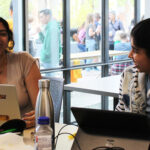
Adams points way to engineering enlightenment

Engineering professor James Adams has been named a President's Professor for 2009. Photo credit: Jessica Slater/ ASU
January 28, 2010
You can learn a lot from a paper clip. Particularly if your teacher is James Adams.
In his introductory materials science and engineering course, he has students bend paper clips to demonstrate fundamentals of metals fatigue.
He turns that into a lesson on the importance of understanding the intricacies of metals fatigue. The knowledge helps, for instance, if you want to do things like prevent aircraft from ripping apart in flight. In other words, it helps if you want to save lives.
Helping students connect the dots between the dry rudiments of science and engineering and the potentially dramatic impacts of applying – or not applying – such knowledge exemplifies what makes Adams an extraordinary teacher, said longtime colleague Stephen Krause.
Adams goes beyond mere instruction, he guides students toward enlightenment, said Krause, a fellow professor in the School of Mechanical, Aerospace, Chemical and Materials Engineering, a part of Arizona State University’s Ira A. Fulton Schools of Engineering.
For that skill to inspire, ASU President Michael Crow selected Adams to receive one of two ASU President’s Professor Awards for 2009, recognizing outstanding contributions to undergraduate education, in and outside the classroom.
Adams, who is the materials science and engineering program chair, has led a restructuring of the program’s introductory course as well as the senior-year capstone materials design course.
Krause says that more than a third of the students were leaving the program after taking the rigorous introductory courses, but following changes spearheaded by Adams, almost 100 percent of the students now stay.
The senior design course also has picked up steam under his direction. He puts students to work on real-world materials design problems faced by industry. Results include several patents shared by students and companies, funding for students’ projects from companies such as Honeywell, Orbital Science and Allied Signal, and job offers.
Adams also developed a mathematical and computational materials science course that has become a model for similar courses at other colleges and universities.
He has been an adviser for more than a decade to Materials Advantage, the undergraduate student professional society, and boosted its membership by helping attract accomplished experts as speakers and organizing promotional events.
“An important reason for the rising morale and dedication of students in the materials undergraduate program is that Jim has inspired students through his guidance of Materials Advantage,” Krause said.
Adams implemented a high school recruiting program that Krause credits in large part for increasing the undergraduate enrollment in the materials program from around 20 to about 90 students over the past several years.
The enrollment increase also brought a notable jump in the number of honors college students in the materials program – 25 percent of them also are in ASU’s Barrett, the Honors College, one of the highest percentages of honors students in any ASU program.
Adams took the lead in creating a semiconductor manufacturing and processing master’s degree program and for many years co-directed the materials doctoral degree program, which was designed to give students a grounding in myriad aspects of science and engineering.
His research focuses in part on thermodynamics, development of new materials to improve the efficiency of vehicle engines and improve communications and energy technology. He also is a leading autism researcher, studying the role of exposure to toxic metals as a factor in the cause of autism.
That work has opened up opportunities for students, who have found internships and jobs through participating in Adams’ research.
He says his success in teaching hinges on keeping classroom instruction as up to date as possible with today’s rapid changes in technology, so that students feel they are studying things that will be applicable to what they will face in the workplace.
He also includes as many hands-on learning exercises and experiments as he can, and keeps students challenged with competitive projects.
One of the most popular has been the Walk on Water competition. Student teams build an apparatus designed to enable someone to traverse across 40 feet on water at the ASU Student Recreation Center swimming pool. Besides the engineering, they must deal with the physics of flotation, motor mechanics and construction technique.
“The final competition day is always exciting and our students talk about it for months afterward,” Krause said.
For Adams, now in his 15th year at ASU, the thrill of teaching is “seeing freshmen come in eager, but clueless” about all that engineering encompasses, “and then years later seeing them come into the senior design course with confidence, and watching them come up with amazing and impressive projects” that lead them to jobs and top graduate programs.
Many students who make that journey say they feel Adams was a big contributor to their progress.
“From his mentorship, I found direction and purpose,” said Urusa Alaan, a 2009 ASU engineering graduate who now is part of a doctoral program in materials science and engineering at the University of California, Berkeley.
Adams made even the toughest engineering course “enjoyable by making it relevant,” Alaan said. “We weren’t learning to get A’s in the class. We were studying to save lives.”



































